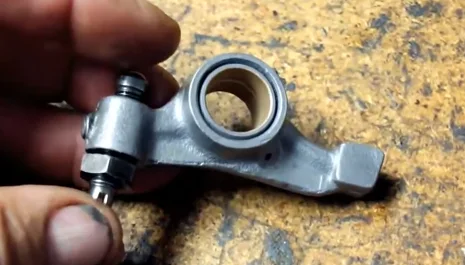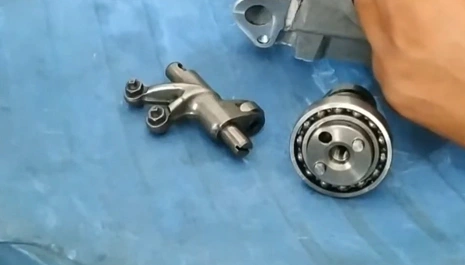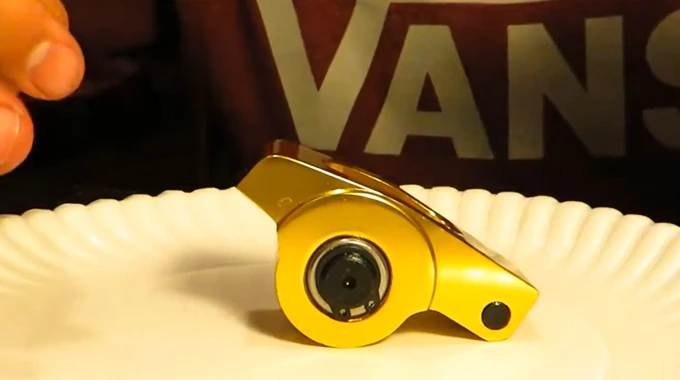Last Updated on April 17, 2023
Car owners often experience a buildup of dirt and grime on the rocker arms of their vehicles. Over time, this grime can harden and cause it to become less effective at controlling the flow of oil to the engine. As a result, the machine will become sluggish and may eventually fail.
It’s not always obvious to know how to clean rocker arms and other sections of your car. Every vehicle depends on dozens of moving parts working properly in order to function, and these are one of the most significant components in an engine.
These arms transfer the motion from the camshaft to the valves, allowing them to open and close at the proper time. The good news is that cleaning them are a relatively effortless process that can be completed in a few simple steps.
How to Clean Rocker Arms : Complete Guide with Simple Steps

Rocker’s arms are often an overlooked component in an engine, yet they play a vital role in its performance. They are usually made of stamped steel or aluminum in high-revving applications, so they are typically quite light.
However, this also makes them susceptible to wear and tear, so they must be inspected regularly for any damage. The joints are coated with oil to help reduce friction. As a result, they must be cleaned very carefully to avoid damaging them. They can be washed in a few different ways.
Tools That Will Be Needed:
Before you begin the task of cleaning your rocker’s arm, you will need to gather a few supplies. It is wise to have all of the required items together in one place so that you can avoid any disruptions during the tidying up process.
The following is a list of items that you will need:
- A Phillips head screwdriver
- Clean rags or shop towels
- A wire brush
- A toothpick
- Engine cleaner (optional)
Now that you have gathered all of the necessary supplies, you are ready to begin cleaning your rocker’s arms.
Step 1: Park Your Car in a Safe and Well-Lit Area
You need to park your vehicle in an area that is well-lit and safe while you are cleaning. This will give you plenty of space to work and ensure that you can see what you’re doing.
Once your car is in place, pop the hood and locate the rocker’s arms. They are located on the side of the engine, near the valve covers. As soon as you find the location of these controls, turn off the motor.
Step 2: Disconnect the Spark Plug Wires
Once your car has been parked safely, it is now time to remove the wires. Identify the plug cables. Due to their location between the spark plugs and the engine, they should be very easy to identify.
When you are able to locate them, gently pull on each one until it comes free from the spark plug. If any of the cords are stuck, use a pair of pliers to loosen them carefully. Next, disconnect the negative terminal from the battery. This will help prevent any accidental electrocutions during the next step.
Step 3: Remove the Engine Cover
Most engines have a plastic or metal cover that protects the inner workings of the device. Therefore, this sheet must be removed. Begin by unscrewing the four bolts with a screwdriver that holds the top in place. Once the bolts are removed, lift the panel off of the car.
You may need to wiggle it a bit to get it free. With the cover off, you should notice the rockers. With a rag, wipe away any dirt or debris that may have built up on them. Next, use a socket wrench to loosen the nut that holds each joint in place. Once the nuts are loose, remove the springs and set them aside.
Be careful not to lose any of the small parts that could have come loose with them. With those removed, you should now be able to see the pushrods.
Step 4: Clean the Rocker Arms
Use a rag to clean off debris or dirt as well. You should begin by removing the surface particles, and then you should work your way into crevices and tight spaces. Use a wire brush or toothpick to remove any lingering stain. Be sure to also sanitize the valve cover stems while you’re at it.
If there is stubborn build-up, you can use a solution designed for engine parts. Just be sure to follow the manufacturer’s instructions carefully. Having thoroughly washed the rocker‘s arms, wipe them down with a rag soaked in fresh automotive oil. This will help protect them from rust and corrosion.
Step 5: Reattach the Spark Plug Wires
Now that you’ve cleaned the rocker’s arms, it’s time to put the plug back in. First, locate the correct spark plug wire for each cylinder. Then, firmly press the end of the cable onto the spark plug terminal.
Make sure that the connection is tight so that no air can enter the cylinder. Finally, route the power cable away from any moving parts or hot surfaces. If you have all of the plug lines connected, your car is ready to start up again.
Step 6: Test Your Car
After you have completed the process of cleaning the rocker‘s arms on your car, it is essential to test your work to ensure that the task was done effectively. The best way to do this is to take your car for a test drive.
Start by driving slowly to see if there are any strange noises or vibrations coming from the control. If everything seems normal, then increase your speed and continue driving for a few minutes. In the event you are satisfied that the arms are functioning properly, you can go ahead and enjoy your clean car.
How Important is It to Keep Your Rocker Arms Clean?

As anyone who has ever changed the oil in their car knows, maintaining a clean engine is important for keeping your vehicle running smoothly.
Many components need to be wiped down regularly, but these are frequently ignored. Rocker panels are quite easy to wash, so they shouldn’t be neglected. Here are a few reasons why it is significant to have them polished:
1. Avoid Engine Damage:
One of the main reasons to do this is to avoid engine damage. When dirt and debris build-up on the arms, it might cause them to wear down and eventually break. In addition, the build-up can restrict oil flow, leading to increased friction and heat.
Over time, this would produce serious injury to the motor. By keeping them clean, you can help to prevent these problems and ensure that your vehicle runs smoothly.
2. Increase Engine Efficiency:
Rocker‘s arms help to transfer energy to the valves from the camshaft, and if they are messy, that process can be disrupted. Thus, the engine may not be able to properly combustion, leading to reduced performance and fuel economy.
Dirty ball joints can also cause excessive wear on mechanical parts, eventually leading to costly repairs. As part of routine maintenance on your car, the rocker’s arms should be inspected often.
3. Extend the Life of the Engine:
Cleaning your rocker‘s arms can also increase the engine’s longevity. As a result of the staining, they have to exert more effort to move, which could wear them out more quickly.
In extreme cases, it might even cause the system to seize. For this reason, it is necessary to regularly maintain your rockers to prevent damage to your motor. Regular cleaning will help to enhance the life of your engine.
FAQ’s
Let’s look at some frequently asked questions that will help you better understand the process of taking care of rocker arms and address any concerns you may have.
How often should I Clean My Rocker‘s Arms?

Your rocker arms are an important part of your engine, and you should keep them clean. The frequency with which you need to inspect them will depend on your driving habits and the condition of your transmission. If you do a lot of stop-and-go traveling or drive in dusty or dirty conditions, you may require to wash your brakes more frequently.
Similarly, if your engine is starting to show signs of wear, it is also a good idea to give the rocker arms a good cleaning. In general, it is recommended to wash them every 5,000 miles or so.
However, this may vary depending on the circumstances. If in doubt, it is always best to err toward caution and scrub them more often rather than less.
What Are The Symptoms of Dirty Rocker Arms?
The rocker arms in a car engine act as a link between the pushrods and the valves. They are responsible for opening and closing pumps at the correct time, which controls the flow of air and gas into the cylinders. Over the periods, however, they can become clogged with oil and debris.
This will cause a number of problems, including motor damage, decreased fuel economy, and poor driving performance. If you suspect that your actuators are dirty or blocked, it’s important to have them inspected by a qualified technician as soon as possible. Ignoring the problem could result in serious mechanical failure.
Why do Do Rocker’s Arms fail?
While rockers are designed to be durable, they can sometimes fail prematurely due to a number of different factors. Among the most common causes of early malfunction is faulty manufacturing. In some cases, parts may be improperly heat treated, which will make them more susceptible to cracking and breakage.
Stress raisers and other elements can also contribute to component poor performance. As a result, it is important to carefully inspect all components before installation to ensure that they meet the highest standards of quality. By taking these precautions, you should help to assure that your rockers will provide years of reliable support.
What Happens If The Rocker’s Arms Are Too Loose?
If the rocker arms on your motor aren’t tight enough, it can cause various problems. The valves may not close completely, which could lead to burnt parts and a loss of compression. The engine might also run erratically and produce less power.
On rare occasions, it may overheat or seize up entirely. To avoid these issues, it’s important to check the control arm adjustment periodically and tighten the adjusters as needed. You can also buy clips that cover the oil holes on hydraulic lifters, which will help keep the valves from burning.
Conclusion
You can maintain your machine correctly now that you know how to clean rocker arms and why it’s important. With a little elbow grease and attention to detail, you can keep your engine healthy for years to come.
This guide should prove helpful, and you might add this to your regular maintenance schedule. Remember, regular maintenance is key to keeping your car in good condition. Check your car’s manual before doing any work. So, what are you waiting for? Get cleaning.
